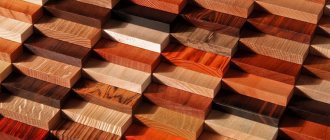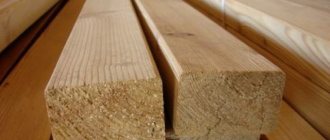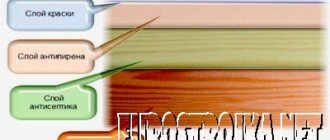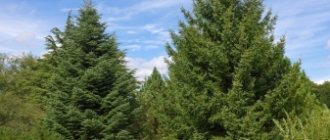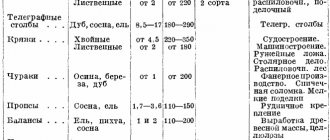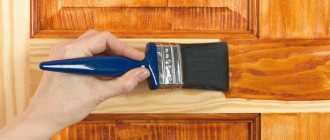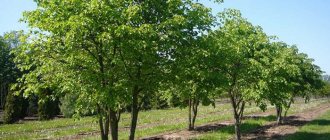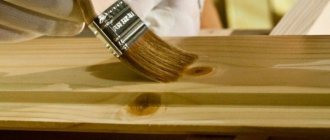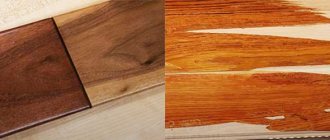What kind of wood sinks in water?
Wood is not a guarantee that a raft built from it will glide across rivers and lakes while remaining a safe watercraft.
There are simply trees that sink in water like iron, because they have an incredibly high density that does not allow them to float on the waves. Piratinera. Also called snake tree. Its specific gravity in dry form is 1500 kg per cubic meter. This is one and a half times the density of water. A piece of such wood sinks to the bottom almost like a stone.
Backout tree structure
Guaiacum. Its second name is Backout. This is the next record holder to go to the bottom like an axe. He comes from the South American continent. It is also unique in density: it is about 1450 kg per cubic meter.
Ipe. Ant tree, Brazil nut, lapacho - all of its names indicate the diversity of the plant. The wood is grayish-red with a density of up to 1300 kg per cubic meter (sometimes about 1100, which is influenced by the region of distribution).
Century-old Boxwood trees
Boxwood. Due to the fact that it is distinguished by hard wood, it serves as a raw material for the production of parts with increased rigidity requirements. It is surprising with a density of 1350 kg per cubic meter. In cross section it has a matte texture of light yellow color.
Quebracho tree cut
Quebracho. “Break the ax” - this is how this name is translated. The density of such trees (there are three varieties) reaches 1200 kg per cubic meter. They grow in Bolivia, Paraguay, Brazil and Argentina. They are distinguished by solid, heavy wood of a black or dark red hue.
Ebony wood blanks
Eben. Another record holder for density, which, like the previous sample, is 1200 kg per cubic meter. Distributed in Central Africa. It is extremely rare and expensive: its cost is calculated per kilogram. Color - from black-velvety to dark brown with characteristic longitudinal veins of a different palette.
Grenadil. A tree with black wood with a density of 1200 kg per cubic meter, which is why it is often confused with ebony, with which it has nothing in common. These are completely different plants. It is found in Mozambique, Tanzania and Kenya. It is under threat of destruction. Also called Dalbergia, Mpingo, Babanus.
Kumaru tree structure
Kumar. It has many names, one of which is Brazilian teak. It has durable wood with a density of about 1150 kg per cubic meter. It sinks, but resists moisture well, so it can be used outdoors.
Larch and its texture
Larch. The representative of the Russian northern latitudes is also characterized by incredible hardness, which is why it quickly sinks. Its density is about 1000 kg per cubic meter, which depends on the zone of distribution (the colder it is, the stronger it is).
Source
New in blogs
Trees that grow in water
Not far from Anapa, almost immediately behind Bolshoy Utrish there is an amazing lake. A lake in which cypress trees grow. This lake is called Suko. Nearby is the village of the same name. There are several options for the origin of its name. Main version: “sukko” translated from Adyghe means “pond for pigs.” That's it, without all the romance, practical and down to earth.
How could cypress trees end up in a pond for animals? Science claims that these trees did not grow in Russia in the past - their homeland is North America.
How did 32 cypress trees grow in this area, which gave the second name to the Sukko reservoir? According to unofficial data, they were brought here and planted during experiments in the 30s of the last century. Oh these thirties - the years of great experiments, bold flights of thought... And since then the trees have taken root and have been here for more than 80 years. This happened thanks to the resinous wood. It does not allow rotting, and therefore these mighty trees are called “eternal”. Their height reaches 50 meters.
This is truly amazing. The serene surface of the lake and cypress trees growing out of the water and forming a semblance of green islands.
The lake is shallow and in the area of trees the water was just above the top of my head. I've never had to swim around trees doing some kind of slalom. Do you know how interesting it is to cling to a branch and climb up? And then, unclench your hands and splash into the warm, gentle water. Unforgettably! The guys are like that, hanging on a branch in bunches of bananas and screaming like a flock of banderlogs. Beauty!
Surprisingly, such a unique place is basically abandoned. The coastline is not equipped, there is no beach as such. And, strictly speaking, there is no entrance either. There is nothing. Does anyone need anything? Toilets, cafes, changing cabins - nothing... Is there anywhere else such a Miracle? I don't know. Strange, really7
But can this stop us from watching and enjoying? Never!
This is such an amazing place. There are even mermaids here, pay attention to the right corner of the previous photo. And what air there is around! Can't convey. Juniper forest. So unusual for me, so strange...
By the way, they say that cypress wood also has beneficial properties. The latter, like wood, has medicinal properties that other plants do not have. Many people know that this resin is used to treat ulcers, ulcers and wounds.
Even in ancient times, for example in Greece, those with respiratory problems and lung diseases were taken to cypress groves so that they could enjoy the aromas released. Cypress Lake (Sukko) is a similar place today. Thanks to the growing trees, a kind of aromatherapy health resort in the fresh air was formed. It is useful to bring here not only patients with respiratory problems, but also those who have cardiovascular diseases and nervous system disorders. The aromas emanating from cypress trees have relaxing properties, they soothe, restore lost strength and relieve irritation. Experts have found that substances released by cypress groves kill microbes and strengthen the immune system.
Experts installed it, but local authorities never bothered to even build a proper road. You can, of course, get to the village of Suko, and then get to the lake. Although, you can get there in another way. We got there in the best car in the world, I’m not afraid to make such loud statements, a car designed for these roads. What kind of car is this, you ask, and you’ll probably think about some Germans or, for example, Japanese? But no. The best car for the place where the great Caucasus ridge begins is the old UAZ, popularly called the “goat”, or its more advanced version “Hunter”.
Believe me, these are real animals. And we had to pull out the Land Rover. He is weak, what can you do...
Here it is, the road leading to the Miracle... Probably, the more interesting this Miracle is, the more difficult the road to it...
And note, only UAZs, no matter what name they are called... After all, we can, when we want, we can! And you also know, no matter how difficult and extreme the road is, the place where it leads is worth all the extreme sports, jumping on potholes, squeals, screams, branches lashing the body and head, and even a meeting with a Gazprom patrol...
After all, only in a fairy tale of gold does the fish immediately fall into the net, and the magic Pike into the bucket.
And if you go to the reeds, go knee-deep into the water and start throwing bread into the water, carps will definitely swim and eat this bread right under your feet, pushing each other and, sometimes, even pushing the feeder. And wasn’t it worth driving through the wild Russian off-road for this? Of course it was worth it. Therefore, if you find yourself in Anapa, be sure to come to Cypress Lake. Come and you will never regret it. Because where else will you see trees? which grow in water? Only here!
And we still have a lot of interesting and beautiful things ahead. Come and let's admire the beautiful world we live in together!
What trees drown in water?
Wood is not a guarantee that a raft built from it will glide across rivers and lakes while remaining a safe watercraft. There are simply trees that sink in water like iron, because they have an incredibly high density that does not allow them to float on the waves.
Piratinera. Also called snake tree. Its specific gravity in dry form is 1500 kg per cubic meter. This is one and a half times the density of water. A piece of such wood sinks to the bottom almost like a stone.
What is density
In physics, the density of a substance is a physical quantity in which the mass and volume of a body are related to each other. Density is an essential and relatively constant feature of a substance, which is widely used to recognize various materials, the nature of which cannot be determined by eye.
Knowing the density of a substance, you can determine the mass of a body.
Any bodies that surround a person in everyday life consist of a variety of materials or substances. In everyday life and industrial activities, people often have to deal with metals, wood, plastics, stone, and so on. Each material has its own density. For this reason, the mass of two different objects that have the same volume, shape and dimensions, but are made from different substances, will be different.
The tree that is drowning
It turns out that not all wood is suitable for building a raft, because using some types of wood, you can get a raft that will simply sink. This is due to the fact that the density of some types of wood is higher than the density of water, and therefore such wood sinks in water.
It should be taken into account that the density of the given examples of wood is higher than the density of water under conditions of a freshly cut trunk and after drying it may turn out to be lower than the density of water.
*For information: the density of water is considered to be 1000 kg/m3, 1 t/m3 or 1 g/ml.
These types of wood have a density greater than that of water and therefore sink in it:
What is larch afraid of?
Larch is an amazing tree in many ways. Hard, resilient, strong and durable - this wood is excellent for use in even the harshest conditions. It is not afraid of frost or moisture, has high biological resistance and belongs to the elite durable breeds.
Interesting materials:
How much is 1,000,000 billion? How much is 100 g of flour? How much is 350 g in Milliliters? How much alcohol can you bring into Tanzania? How many Armenians are there in America 2022? How many bytes are in a 32 bit integer? How many points are given for each exam mathematics task? How many points are given for writing and essays in English? How many points does Kari get for her birthday? How many points can you get for presenting Russian OGE?
Larch
Larch . Dense, hard and rot-resistant wood. The density reaches 1100 kg/m3, but this is in a freshly cut state; when dried, it becomes lighter than water. Read more here.
Eben , aka Ebony tree. Ebony wood is one of the densest. Density values can reach up to 1300 kg/m3, and even after drying, the wood remains denser than water. This is a rare and very expensive wood. Its color ranges from brown to black-velvety with streaks of lighter wood.
Grenadil . The tree has black wood, the density reaches up to 1200 kg/m3. The wood is also characterized by increased hardness. Other names: babanus, mpingo, dalbergia. Not to be confused with ebony - these are different types of trees.
Kumara . And also Brazilian teak is the commercial name for the wood of the Dipteryx tree. The texture is beautiful, due to the complex pattern of fibers. The density of wood reaches 1150 kg/m3.
Azobe . Scientific name: Lophyra winged. Also called "Bongossi". Density reaches up to 1150 kg/m3, on average 1050 kg/m3. A distinctive feature is good resistance to putrefactive lesions and insect pests.
Larch . Dense, hard and rot-resistant wood. The density reaches 1100 kg/m3, but this is in a freshly cut state; when dried, it becomes lighter than water. Read more here.
More articles from the section All about wood :
What does it look like
Most Russians are accustomed to believing that birch is distinguished from other trees by its white bark. But the plant we are interested in is not similar to the widespread representatives of its family. The bark of young branches of the Schmidt birch is dark cherry, and on old trunks it is dark gray. And if you separate the surface layer, then underneath you can see areas of brown bark with a bizarre purple tint.
The famous florist and dendrologist Dmitry Vorobyov in the book “Wild-growing trees and shrubs of the Far East” (Leningrad, 1968) writes that the Schmidt birch reaches a height of 20-25 m, and the trunk diameter of old trees is 80 cm. True, the tree has such parameters reaches only at the age of 300-350 years, because it grows very slowly, especially in the first 50 years of its life.
The crown of the old Schmidt birch begins at a height of 8-10 m. The length of its leaves is about 7 cm, the width is from 3 to 5 cm. Moreover, in young plants the leaves are narrower, while in adults they are slightly wider. The tree is propagated by seeds and cuttings; it is successfully cultivated in the botanical gardens of the Far East, St. Petersburg, Moscow and other cities of Russia.
Schmidt birch buds usually open by May 10th. It blooms with earrings until May 20. The seeds ripen in September; they are light brown nuts up to 2 mm in size. By the end of October, the tree completely sheds its foliage.
Experts believe that the Schmidt birch is an ancient relic; it is older than other representatives of its family and grows much longer than ordinary white-trunked beauties.
What tree can drown in water?
Parrotia persica is the most durable ironwood. A deciduous tree with a broadly ovate crown and a trunk covered with sulfur, sometimes reddish-brown exfoliating bark, up to 25 meters or more in height. The branches of a plant often take root and grow together both with each other and with the branches of other trees, and since the plant usually forms several trunks, which often also grow together with each other and with the trunks of other trees, sometimes impenetrable thickets are formed. It grows slowly and lives up to 200 years.
Amazonian wood native to Brazil, ebony, rosewood or rosewood, cumaru - all of these trees have very hard and dense wood, rich in oils, the bark of these trees is resistant to rot, and they are all heavier than water. Therefore, you shouldn’t make boats out of them, but you won’t find better material for making furniture than these trees.
Schmidt birch - grows in the southern part of the Primorsky region in the Kedrovaya Pad nature reserve. The wood of this birch is 1.5 times stronger than cast iron and can easily replace metal. The lifespan of the Schmidt birch is about 400 years, like no other birch on the planet.
The term is applied to trees with heavy hardwood. Ixora iron is an Antillean iron tree. Casuarina is a genus of casuarinaceae. Mesuya ironwood is a Ceylon ironwood. Parrotia persica - grows in Northern Iran and Azerbaijan. Pohutukawa is a New Zealand ironwood tree. Thuja occidentalis is an evergreen coniferous tree. Hmelegrab is a genus of trees in the birch family. Caesalpinia ferruginosa is a Brazilian ironwood tree. Some species of the genus Sideroxylon
Source
Where does it grow
On behalf of the Imperial Russian Geographical Society, Fyodor (Friedrich) Schmidt participated in a scientific expedition to the Far East in 1859-1862. He described in detail the nature of the Amur region and Sakhalin, including an amazing tree that received its name in honor of the scientist.
Schmidt's birch (Betula schmidtii) in Russia grows in the south of Primorsky Krai. It is also found in China - in the east of Jilin province and northeast of Liaoning province, in the central part of the Japanese island of Honshu and in Korea. Employees of the Far Eastern Branch of the Russian Academy of Sciences E. A. Pimenova, V. Yu. Barkalov, M. N. Koldaeva, S. V. Nesterova, E. A. Petrunenko, V. A. Kalinkina and P. V. Krestov spoke about this in the article “Rare species of vascular plants in the territory of the Land of the Leopard National Park (Primorsky Territory, Russia).” The collective work of scientists was published in the journal Turczaninowia (Vol. 19, No. 2, 2016).
If we talk about our country, Schmidt birch is quite rare in the wild. It is listed in the Red Book of Russia. This tree usually grows on rocky soil. As a rule, small groups or single specimens can be found on the northern, northwestern or northeastern slopes of the coastal hills at an altitude of up to 650 m above sea level. This tree also grows along the edges of ravines. But it does not tolerate swampy and heavily moist soil. In the forest thickets, Schmidt's birch peacefully coexists with pines, firs, oaks, maples and lindens.
Candidates of biological sciences Raisa Korkishko and Elena Saenko wrote an article “90 years of the state natural biosphere reserve “Kedrovaya Pad””, which was published in the “Bulletin of the Far Eastern Branch of the Russian Academy of Sciences” (No. 5, 2006). The authors noted that Schmidt’s birch is found on the territory of the reserve, which is located in the Khasansky district of Primorsky Krai. There this unique tree is under the supervision of scientists.
